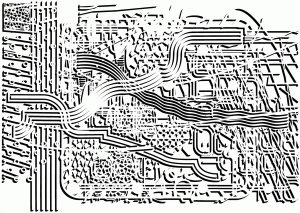« Reviews
Schoolism – Argentine Art of the 1990s

Pablo Siquier, 0508, 2005, Acrylic/canvas 78.7” x 110”. This artwork was acquired thanks to the contribution of Felicitas & Alec Oxenford, Sergio Quattrini and Asociación Amigos de MALBA, Photo Courtesy MALBA
MALBA (Museo de Arte Latinoamericano de Buenos Aires)
June 19 – August, 2009
By María Carolina Baulo
The idea for this show begins with the text written by Ricardo Martin-Crosa (1927-1993) at the end of the 1970s Schoolism (Semiotic models from school in Argentine painting), in which the well-known author (priest, poet, professor of aesthetics and hermeneutics, with studies in theology, philosophy and literature), questions originality in the language of Argentine art. He then developed a hypothesis in which he highlights the importance of the way of thinking, seeing and doing that corresponds to the learning model of an Argentine primary school. Martin-Crosa finds some characteristics shared by Argentine artists who relate images with the models learned in primary school: perfection, assemblages, handicrafts, tidiness, cutting and pasting, collages, among others. All the artists participating in the exhibition (Liliana Porter, Elba Bairon, Feliciano Centurión, Beto De Volder, Tomás Espina, Ignacio Iasparra, Guillermo Kuitca, Fernanda Laguna, Liliana Maresca, Adriana Miranda, Eduardo Navarro, Marcelo Pombo, Pablo Siquier, Eduardo Stupia, Ruy Krygier, Sergio Avello, Leo Battistelli, Fabían Burgos, Marina De Caro, Mónica Girón, Gumier Maier, Catalina León, Nushi Muntaabski, Nicolás Robbio, Omar Schiliro, Alejandra Seeber, Román Vitali, Gabriel Acevedo Velarde, Ale De la Puente, Matías Duville, Manuel Esnoz, Leopoldo Estol, Raúl Flores, Sebastián Gordín, Daniel Joglar, Fabio Kacero, Jorge Macchi, Miguel Mitlag, Alberto Passolini, Alfredo Prior, Cristina Schiavi) produced pieces in which school context was one of the main sources that nurtured the ways and means in which they organized their production.
As Martin-Crosa said: “we should first identify what we would call rhetoric of Argentine primary education: a list of formal means primary schools use for transmitting their contents. These means can influence the recipient more than the contents themselves.” So he determines some guidelines on which to base his ideas: Primary education is leveling (meaning there is no order of importance in the way contents are arranged, becoming sometimes juxtaposed), emphatic (according to the importance given to the contents), mythifying (because it creates models), formal (because of the attention given to the formal aspect and the effort required), operational (elements are interchangeable and could create multiple structures). Therefore, many Argentine artists grew up influenced by these learning methods; an atmosphere of order that impacted their choices.
This exhibition invites us to reconsider “schoolism,” so as to understand Argentine art of the 1990s from a different perspective. Similarities and differences appear in the artists’ works, representing distant generations. Three thematic cores define three areas in the room following no special order: Materials and Signs (school handicrafts, art workshops, practical activities and complementary subjects), Assemblages and Activities (everything related to building, sewing, folding, constructing, creating, ordering, cutting, fixing, mixing, etc.), Childhood Imagery (iconographies related to album stickers, cartoons, comics, science fiction, fantastic visions, caricatures, etc.)
“Schoolism,” made up mostly of works from the MALBA collection, attempts only to give a new point of view to the many existing ones, regarding contemporary Argentine art. It is interesting to find that a concept created in the late 1970s is still alive and useful in approaching the Argentine artistic scene of recent decades.
María Carolina Baulo: Art writer, Master’s Degree in History of Art, with studies in Cinematography, Photography and Theatre. macabaulo@hotmail.com
Filed Under: Reviews


































